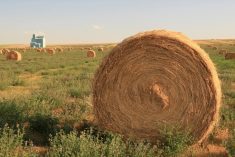Pastures evolve over time. Woody plants and shrubs, which cattle can’t eat, may encroach on natural grasses. Invasive species, such as Kentucky bluegrass, may also move in, cutting into native grass productivity.
One way of managing this is through fire.
At the Saskatchewan Beef Industry Conference, Eric Lamb and Renny Grilz presented recent research regarding prescribed burns, as well as what the potential benefits are for producers who may use fire in their management practices. However, there is still much research to be done, and a lot to know to effectively and safely work with fire.
Read Also

The Canadian Cattle Association’s international advocacy efforts
Global ag policies affect Canadian food policy, so the Canadian Cattle Association participates in international and domestic forums
Effects of prescribed burns
Though Eric Lamb started out as a general grassland ecologist, his research led him toward prescribed burns. Now, that is his main research focus at the University of Saskatchewan.
Historically, wildfires were common in grasslands and necessary for evolution. However, once people started managing native grasslands for cattle and livestock production, they suppressed fires. Lamb says some pastures he works on haven’t been burned in 90 to 100 years when it used to occur every two to five years.
“I’ve been becoming much, much more active in research on that side of things, saying, ‘Well, if we think fire is more important for management, we need more and better information on exactly when, exactly how much, to achieve particular goals.’”
Lamb says there are many benefits to using fire to manage grasslands. Not only is it a way to push back unwanted things like shrubs, but it also benefits forage quality.
Forages that grow in a grassland post-burn have a higher protein content and a lower fibre content. That means for every bite of grass, the cattle get more nutrients than they would have before the burn.
The grass is easier to access in the early spring days of grazing because the litter was burned in the fire.
“What we see, in a recently burned area, is the grazers will seek those locations out as kind of a preferred grazing area,” Lamb says.
While there has not been research done in Canada to say whether this has changed the health of the cattle grazing recently burned land, research has been done down south. In the U.S., some studies have found the cattle have better weight gain.
In addition to pushing back woody shrubs and removing excessive litter, prescribed burns can also be used to target specific invasive species, such as Kentucky bluegrass. In certain situations, people can protect buildings from future wildfires by burning around them.
“We often view fire as a danger to infrastructure but remember that we can also use fire to remove fuel under safe conditions, and this reduces the risk of wildfire conditions,” Lamb says.

Current research
Lamb is now starting a research project in the Foam Lake Community Pasture. He is focusing on how prescribed burns can affect shrub control and comparing different treatments to see which are the most effective at keeping shrubs back for longer.
“One of the problems with any method for woody plant control is the plants just come back,” Lamb says.
Because of this, it takes several years of effort to really knock the shrubs back. The research will examine if there is a benefit to a mixed approach in dealing with the shrubs, such as using a herbicide one year and a prescribed burn the next.
“It may well be that there’s some more effective combinations of control methods with fires being only one of the potential tools in your toolbox.”
The research is funded by Saskatchewan’s Agriculture Demonstration of Practices and Technologies program.
There is more research going on through the University of Saskatchewan. Renny Grilz is the resource management officer with the Meewasin Valley Authority in Saskatoon, where he oversees prairie restoration, prescribed fire management and targeted grazing programs.
He has been involved with many prescribed burn projects, including one at the Spy Hill Community Pasture and one at the Aberdeen Community Pasture.
At both community pastures, the goals were the same: reduce shrub and tree encroachment, attract livestock into the burned area of the pasture, reduce excessive litter accumulation and reduce wildfire risk. The burn unit in Aberdeen was around 23 acres that had been left ungrazed for 15 years. They’ve done one prescribed burn and have seen many benefits, as it burnt down a large portion of aspen and willow oaks. They hope to do more burns soon.
In Spy Hill, the burn unit was 850 acres. They were very concerned about the risk of wildfire, and so they did a large-scale burn. After that burn, aspen regrowth was set back.
“They’re expecting they’re probably going to have to do a fire in three or four years again to try and knock back some more of that aspen,” Grilz says.
What producers should know
Despite all this research, there is still more that needs to be done to increase the knowledge about the effects fire may have on grasslands. For example, Lamb says there are many benefits for native prairie, but not enough research has been done on the tame grass side.
Producers can start implementing prescribed burns if they feel inclined, but safety must be ensured.
Lamb recommends everyone get training from the Canadian Prairies Prescribed Fire Exchange. The online course, available at grasslandfire.ca, takes 15 hours and the current price is under $200.
After the course, people should do practical training before attempting a prescribed burn. Lamb recommends finding local groups already doing prescribed burns and joining their fire crew. Doing so gives people boots-on-the-ground experience with a prescribed burn. Lamb says often, working on these fire crews will help people form a prescribed burn association, where neighbours can help each other out when necessary.
“Because ultimately, it’s neighbours helping each other to manage lands within their local area. And if you can build up something like that, along with support from your… (municipal) fire department and things like that, it’s quite possible that this can be done very safely and at a big enough scale to actually make a difference for management.”
Some of these prescribed burn associations already exist. Lamb says in Saskatchewan, they are mostly associated with some level of government. These groups are usually part of the Canadian Prairies Prescribed Fire Exchange.
If a producer is doing a prescribed burn, the frequency of burning depends on their goals, whether it’s improving forage, pushing back shrubs or minimizing litter.
For example, after a burn, it usually takes forages five years to produce at the volume before the burn, so producers would want to wait at least five years between burns. But if someone is trying to repress woody shrubs or trees, Lamb says they might want to burn every other year or every three years. Then, they might not have to burn again for a decade.
Regardless of why a producer is burning pasture, to be successful and safe, people need to have respect for the fire.
“Fire can be a destructive force. But in grasslands, it can also be a renewing force.” c
Melissa Jeffers-Bezan is a field editor for Canadian Cattlemen and a graduate of the University of Regina School of Journalism. She grew up on a commercial cattle farm in western Manitoba, and is now based out of Regina.

















